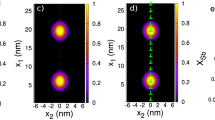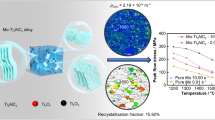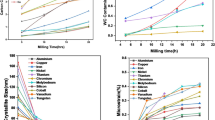The paper shows that X-ray diffraction can be used to evaluate changes in the energy content of materials after mechanical activation to determine the energy characteristics of powder tungsten and molybdenum carbides in the feedstock preparation process. This is important for controlling the properties of tungsten carbide hardmetals and inoculating castings using molybdenum carbides.

Similar content being viewed by others
Notes
ΔE d = K ⋅ E l, where K is the coefficient of relative change in volume of the elementary cell of the concentrate phase; E l is lattice energy of the mineral.
ΔE s = 6E s V mol(1/D i – 1/D o), where E s is surface energy; V mol is molar volume; D i , D o are sizes of CSDs for the mineral after and before MA.
\( \varDelta {E}_{\varepsilon }=\frac{3}{2}{E}_{\mathrm{Y}}\left({\varepsilon}_i^2-{\varepsilon}_{\mathrm{o}}^2\right)\ {V}_{\mathrm{mol}} \), where E Y is Young’s modulus; ε i , εo are root-mean-square microstrains of the mineral after and before MA.
For anions, ec = z 2/2r; for cations, ec = z 2/2r0.75 (r + 0.2).
ΔE МАd is the amount of energy used to change interplanar spacing in lattice during MA.
ΔE МОd is the amount of energy used to change interplanar spacing in lattice during thermal destruction of metal organic mixtures.
References
G. Gille, B. Szeny, K. Dreyer, et al., “Submicron and ultrafine grained hard metals for microdrills and metal cutting inserts,” in: Proc. 15th Int. Plansee Seminar, Reutte, Austria (2001), Vol. 2, pp. 782–816.
Lin Sha Gang, Yang Gnibin, et al., “Production of nanocrystalline WC/Co with Y additions,” J. Chin. Rare Earth Soc., 21, No. 6, 29–34 (2003).
A. G. Ermilov, V. V. Safonov, L. F. Doroshko, et al., “X-ray analysis of the amount of energy stored during preliminary mechanical activation,” Izv. Vuzov. Tsvet. Metall., No. 3, 48–53 (2002).
B. F. Ormont, Introduction to Physical Chemistry and Crystal Chemistry of Semiconductors [in Russian], Vysshaya Shkola, Moscow (1973), p. 656.
V. A. Alekseenko, “Basic factors of accumulating chemical elements by organisms,” Soros. Obraz. Zh., 7, No. 8, 20–24 (2001).
V. V. Zuev, G. Ya. Askenova, N. A. Mochalov, et al., “Using specific lattice energies of minerals and inorganic crystals to evaluate their properties,” Obogashch. Rud, No. 1–2, 48–53 (1999).
I. T. Goronovskii, Yu. P. Nazarenko, and E. F. Fekryach, A Short Chemistry Handbook [in Russian], Izd. Akad. Nauk USSR, Kiev (1962), p. 660.
K. A. Bol’shakov, Chemistry and Technology of Rare and Trace Elements [in Russian], Vysshaya Shkola, Moscow (1976), Part 3, p. 321.
R. A. Andrievskii and I. I. Spivak, Strength of Refractory Compounds and Associated Materials: Handbook [in Russian], Metallurgiya, Chelyabinsk (1989), p. 368.
T. Ya. Kosolapova, Carbides [in Russian], Metallurgiya, Moscow (1968), p. 300.
Wear-Resistant Materials with High Hardness: Superhard Materials, Metallic Compounds, Nonmetallic Oxygen-Free Compounds; Information for Engineers; R&D, Engineering Calculations and Services; URL: http://www.highexpert.ru/content/hwr_materials/ hard_materials.html (inquiry date: May 17, 2013).
Tungsten Carbide (WC), Bulk; An information portal for the MEMS and Nanotechnology Community; URL: http://www.memsnet.org/material/tungstencarbidewcbulk (inquiry date: May 27, 2013).
Mc. A. J. Ginnis, R. Thomas, W. Jagannadham, and K. Jagannadham, Residual Stresses in a Multilayer System of Coatings, Copyright JCPDS, International Centre for Diffraction Data (1999), pp. 443–457.
G. V. Samsonov (ed.), Carbides and Their Alloys [in Russian], Naukova Dumka, Kiev (1976), p. 305.
G. I. Kostyuk and O. M. Melkozerova, “Evaluating adhesion characteristics of materials in contact with coatings,” Aviats. Kosm. Tekh. Tekhnol., No. 3, 16–22 (2011).
V. A. Rabinovich and Z. Ya. Khavin, A Short Chemistry Handbook [in Russian], Khimiya, Leningrad (1977), p. 376.
M. I. Dvornik and E. A. Mikhailenko. “Hardness evaluation of VK8 hardmetal with the finite-element method,” Khim. Fiz. Mezoskop., 11, No. 4, 433–440 (2009).
A. N. Zelikman and L. S. Nikitina, Tungsten [in Russian], Metallurgiya, Moscow (1978), p. 272.
A. G. Ermilov, N. N. Rakova, A. F. Borun, and A. M. Dodonov, “Factors influencing the formation of metal–carbon bonds in organometallic mixtures,” Izv. Vuzov. Tsvet. Metall., No. 1, 28–34 (2007).
G. M. Vol’dman, A. G. Ermilov, and N. N. Rakova, “Oxygen effect on the production of nanosized tungsten- and molybdenum-containing powder materials,” Tsvet. Met., No. 8, 82–86 (2007).
A. G. Ermilov, E. V. Bogatyreva, and T. A. Sviridova, “Composition and parameters of tungsten-containing nanocrystalline organometallic structures,” Izv. Vuzov. Tsvet. Metall., No. 4, 47–51 (2009).
A. N. Zelikman, Molybdenum [in Russian], Metallurgiya, Moscow (1970), p. 440.
A. G. Ermilov and N. N. Rakova, “Factors influencing the thermal stability of metastable phases of tungsten and molybdenum subcarbides,” Tsvet. Met., No. 1, 67–69 (2007).
A. G. Ermilov and N. N. Rakova “Effect of nucleation centers on nanostructure formation during decomposition of organometallic compounds,” Izv. Vuzov. Tsvet. Metall., No. 5, 46–54 (2007).
V. V. Zuev, G. A. Aksenova, N. A. Mochalov, et al., “Studying the specific lattice energies of minerals and inorganic crystals to evaluate their properties,” Obogashch. Rud, No. 1–2, 48–53 (1999).
V. Falcovsky, Y. Blagoveschski, L. Klyachko, et al., “Nanocrystalline WC–Co hard metals produced by plasmochemical method,” in: Proc. 15th Int. Plansee Seminar, Reutte, Austria (2001), Vol. 2, pp. 91–96.
Author information
Authors and Affiliations
Corresponding author
Additional information
Translated from Poroshkovaya Metallurgiya, Vol. 53, Nos. 7–8 (498), pp. 69–80, 2014.
Rights and permissions
About this article
Cite this article
Bogatyreva, E.V., Ermilov, A.G. Evaluating the Energy Content of Nonequilibrium Tungsten and Molybdenum Carbide Structures. Powder Metall Met Ceram 53, 431–440 (2014). https://doi.org/10.1007/s11106-014-9635-x
Received:
Published:
Issue Date:
DOI: https://doi.org/10.1007/s11106-014-9635-x




